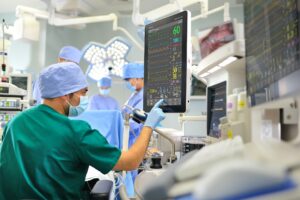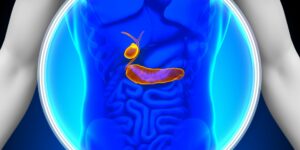
Bile is essential for breaking down fat, removing waste from the body, and neutralizing stomach acid. Bile ducts transport bile from the liver to the small intestine but can be blocked by gallstones, tumors, inflammation, and injuries. This results in uncomfortable and potentially serious symptoms that can impact your digestive system, liver function, and overall well-being.
Common symptoms of bile duct obstruction include:
- Changes in urine and stool color
- Jaundice
- Abdominal pain
- Itching
- Fever and chills
What Is Bile Duct Obstruction?
Bile duct obstruction is a blockage in the bile ducts that transport bile from the liver to the small intestine through the gallbladder. This causes bile to accumulate in the liver and the levels of bilirubin, a yellow pigment produced from the breakdown of red blood cells, rise in the bloodstream.
Common causes include:
- Gallstones
- Tumors
- Inflammation
- Trauma
Treatment aims to relieve the blockage and may involve hepatobiliary procedures such as liver and pancreatic resections, cholecystectomies, and Whipple procedures. If left untreated, bile duct obstruction can lead to serious complications including infections, sepsis, and chronic liver diseases like biliary cirrhosis.
- Changes in Urine and Stool Color
Changes in urine and stool color are significant indicators of bile duct obstruction. Dark urine occurs when excess bilirubin is excreted through the kidneys, resulting in a deep amber or cola-like appearance. This happens because the blocked bile ducts prevent bilirubin from being properly eliminated through the intestines.
Pale or clay-colored stools develop due to the lack of bile reaching the intestine. Bile gives stool its characteristic brown color, so when it’s absent, stools become light-colored or clay-like. These stools may also appear oily and float in water due to undigested fats.
These changes are crucial diagnostic indicators as they directly reflect your body’s inability to process and eliminate bile properly. Persistent alterations in urine and stool color, especially when accompanied by other symptoms like jaundice, warrant immediate medical attention as they can signify serious underlying liver or biliary system issues.
- Jaundice
Jaundice is a common symptom of bile duct obstruction, characterized by yellowing of the skin and whites of the eyes. It occurs when bilirubin accumulates in the bloodstream. Bile duct obstruction blocks the normal flow of bile from the liver to the small intestine, causing bilirubin to build up in the blood and tissues.
The severity and progression of jaundice in bile duct obstruction can vary. It may appear suddenly or develop slowly over time. Initially, jaundice might be transient, occurring during acute exacerbations of the underlying condition. The yellowing typically becomes more pronounced as bilirubin levels increase with severe fibrosis and calcification setting in.
- Abdominal Pain

Abdominal pain is typically localized in the upper right or upper middle of the abdomen. The pain is often described as dull and persistent, gradually increasing over several minutes. It may be accompanied by a feeling of fullness or discomfort in the upper abdomen. Factors that can worsen the pain include eating fatty foods, which stimulate bile release.
The pain may worsen after meals when the gallbladder contracts to release bile. Pressure applied to the affected area can also intensify the discomfort.
Telling the difference between bile duct obstruction pain from other abdominal conditions can be challenging on your own. Unlike the cramping pain associated with intestinal issues, biliary pain tends to be more constant.
The location and nature of the pain, combined with other symptoms like jaundice and changes in urine or stool color are all important indicators. They can help distinguish a bile duct obstruction from conditions such as appendicitis or gastritis.
- Itching
Itching in bile duct obstruction, known as cholestatic pruritus, occurs when bile salts accumulate in the skin. The severity of itching can vary from mild to intense and is often widespread, affecting the entire body. It may worsen at night, leading to sleep disturbances.
Chronic, severe itching can significantly impact your quality of life, causing:
- Anxiety
- Depression
- Social isolation
The persistent urge to scratch can also lead to skin damage, making the discomfort worse and potentially causing secondary infections.
- Fever and Chills
Fever and chills are common symptoms of bile duct obstruction, primarily due to the increased risk of infection in the obstructed ducts. When bile flow is blocked, bacteria can multiply in the stagnant bile, leading to cholangitis, an infection of the bile ducts. This infection triggers the body’s immune response, resulting in fever and chills.
The combination of fever, chills, and abdominal pain is known as Charcot’s Triad, a classic sign of acute cholangitis.
Immediate medical attention is necessary if fever and chills occur alongside severe abdominal pain, jaundice, or signs of sepsis such as low blood pressure. These symptoms can indicate a life-threatening infection requiring urgent treatment with antibiotics and possibly surgical intervention.
Expert Treatment with Evansville Surgical Associates
Evansville Surgical Associates delivers outstanding surgical care in Evansville, IN, and the Tri-State area. Our skilled surgeons and dedicated staff follow a holistic approach to your care, prioritizing minimally invasive techniques whenever possible. We work with primary care and rehabilitation experts to ensure comprehensive treatment.
At Evansville Surgical Associates, you receive top-quality expertise from local surgeons. We focus on patient-centered care, prioritizing your comfort and education. With a doctor on call 24/7, we provide continuous support and exceptional surgical services in the community.
Are you living with symptoms of a bile duct obstruction? Contact us today!
Bile duct obstruction causes noticeable changes in urine and stool color. Dark urine and pale stools result from improper bile processing. Jaundice, abdominal pain, itching, fever, and chills are common symptoms. These signs, especially when persistent, require immediate medical attention as they may indicate serious liver or biliary issues. Evansville Surgical Associates offers expert surgical care for such conditions in the Tri-State area.
Evansville Surgical Associates has been providing comprehensive and compassionate surgical care for over 50 years. Call us at (812) 424-8231 or (800) 264-8231 to contact us or schedule an appointment. We are available from 8:00 a.m. to 4:30 p.m. Central Time.



